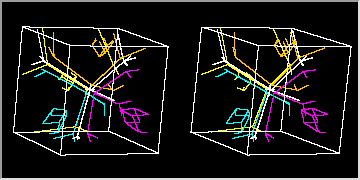Home
> 4D Maze Game
Download
|
The Idea
In the Maze
> Notes
Reference
The Fourth Dimension
Can You See It?
|
The Tesseract
The Tesseract, Part Two
|
> The Hexadecachoron |
How Much Space Is There?
Rotations
How to Point
How to Orient Yourself
Volumes
Walls Are Opaque
|
Some Mathematics
Bibliography
The Hexadecachoron
The hexadecachoron is the four-dimensional analogue of the octahedron. Just as an octahedron has eight sides (“octa-hedron”) that are triangles, so does a hexadecachoron have sixteen volumes (“hexadeca-choron”) that are tetrahedra. The hexadecachoron is not nearly as relevant to the maze world as the tesseract, but it does show up occasionally, so I thought I would say a little about it.Actually, first I will say a little about the tetrahedron and octahedron, in case you're not familiar with those figures.
The tetrahedron is the three-dimensional analogue of the triangle. It is a kind of pyramid with a triangular base, and has four sides that are (equilateral) triangles. Four-sided dice are tetrahedra. (In case you're wondering, yes, there is also a four-dimensional analogue of the tetrahedron, namely, the pentachoron. It doesn't show up in the maze world.)
As for the octahedron, well, eight-sided dice are octahedra. The octahedron is also the dual of the cube. What that means is, if you take a cube, put a vertex at the center of each face, and connect them up, you get an octahedron; and if you do the same with an octahedron, you get a cube.
In the same way, the hexadecachoron is the dual of the tesseract. Consequently, if you want to see the vertices of a hexadecachoron, all you need to do is find a way to see the face centers of a tesseract.
I found one way by accident. If you're looking down a passage, the end of the passage occupies the same space as the face center would, if there were a wall (or face) in front of you instead of a passage. So, if you can find a square that has four orthogonal passages, the ends of those passages will be the vertices of one face of a hexadecachoron.
Later, I found another, much easier way to see the face centers: turn on texture number 1. If we do that, and then go back and look at the tesseract vertex again, we can also see the vertices of one tetrahedral face of a hexadecachoron.

See Also
How Much Space Is There?